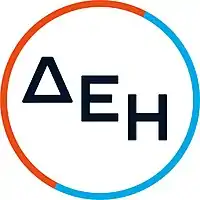Public Power Corporation
The Public Power Corporation S.A. (Greek: Δημόσια Επιχείρηση Ηλεκτρισμού, romanized: Dimosia Epicheirisi Ilektrismou; ΔΕΗ) is the biggest electric power company in Greece. It is controlled by the Greek government, which owns a majority of the issued shares (51,12%).
 | |
Native name | Δημόσια Επιχείρηση Ηλεκτρισμού |
|---|---|
| Type | Public |
| Athex: PPC | |
| Industry | Energy |
| Founded | 1950 |
| Headquarters | , Greece |
Key people | Georgios Stassis (Chairman) |
| Products | Electric power, natural gas |
| Services | Electrical power distribution, natural gas provider |
| Revenue | |
| Total assets | |
| Total equity | |
| Owner | Hellenic Corporation of Assets and Participations S.A. (51.123%)[1] |
Number of employees | 16,747 (2018) |
| Website | www |
| Footnotes / references financial figures are in group, but excluding IPTO[2]:7 | |
History
PPC was founded by the Greek government in 1950. Its main purpose was to plan and apply a national energy policy which, through the exploitation of the domestic products and resources, would distribute cheap electric power to all Greek citizens. PPC started the integration of all the small local grids to the national interconnected grid. Furthermore, the corporation resolved the purchase of all the small private and local electric power production units.
Today, PPC Group consists of 3 subsidiary companies PPC or DEI S.A., the Hellenic Electricity Distribution Network Operator (HEDNO or DEDDIE) S.A. and PPC RENEWABLES S.A.[3] Even if HEDNO S.A. (the Greek DSO) is owned by PPC, HEDNO S.A. operates independently according to L.4001/2011 and in compliance with 2009/72/EC EU Directive relative to the electricity market organization.[4]
Shareholders
In the past five years there has been no change in the share capital of the Company. The Company’s shares are traded in the «Large Cap» category of the Athens Stock Exchange (ATHEX), while in the London Stock Exchange they are traded in the form of global depository receipts (GDRs).
The Company’s shareholding structure as of 7 September 2018 was as follows:[5]
| Shareholders | Percentage |
|---|---|
| Hellenic Corporation of Assets and Participations S.A. (HCAP) owned by Greek state | 34.12% |
| Hellenic Republic Asset Development Fund (HRADF) | 17.00% |
| EFKA Single Social Insurance Fund(state-owned organisation) | 3.93% |
| Institutional Investors & general public | 44.95% |
| Total | 100.00% |
Economy
In 2001, PPC carried out a share flotation on the Athens Stock Exchange and consequently is no longer wholly owned by the government, although it is still controlled by it with a 51.1% stake.
In June 2011, the Greek government announced it would sell 17% of its share of PPC to meet conditions of EU/ECB/IMF loan package. The workers of PPC responded by limited power cuts to selected towns across Greece.[6] However, this plan is now in jeopardy as the incoming Tsipras Government has decided to suspend the privatization of PPC as one of its first anti-austerity measures.
Renewable energy
In 1982, PPC developed the first Wind Farm in the world, combined with a Photo-voltaic Station to supply electricity to the isolated power system of the island of Kythnos.[7]
The PPC has committed to buying renewable-source energy from independent producers at five times its selling rate until 2034.
Legislation before Parliament in 2013-14 included making the PPC responsible for collection of the real estate tax, part of the EU/IMF/ECB requirements for the financial support of the economy.
Power plants
The 34 major thermal and hydroelectric power plants and the 3 wind farms of the interconnected power grid of the mainland, as well as the 60 autonomous power plants located on Crete, Rhodes and other Greek islands (33 thermal, 2 hydroelectric, 18 wind energy and 5 photovoltaic parks) form PPC's industrial assets and constitute the energy basis of all financial activities of the country.
The total installed capacity of the 97 PPC's power plants is currently 12,760 MW with a net generation of 53.9 TWh in 2007.
Carbon intensity
| year | Production (TWh) | Emission (Gt CO2) | kg CO2/MWh |
|---|---|---|---|
| 2002 | 49 | 51.35 | 1050 |
| 2003 | 52 | 52.41 | 1004 |
| 2004 | 53 | 53.29 | 1015 |
| 2005 | 53 | 52.59 | 994 |
| 2006 | 52 | 50.48 | 969 |
| 2007 | 54 | 53.04 | 984 |
| 2008 | 52 | 52.2 | 996 |
| 2009 | 50 | 49.7 | 992 |
Mining areas
PPC has mining areas adjacent to many of its power plants. Some of these power plants produce electricity and power from lignite, while other plants use coal. The largest mining areas are located between Kozani and Ptolemaida, around Amyntaio in the Florina prefecture and around Megalopolis.
See also
References
- "PPC's Shareholding Structure | PPC S.A." www.dei.gr. Retrieved 13 January 2021.
- Annual Report 2017
- "PPC Group - PPC S.A." www.dei.gr. Retrieved 13 February 2020.
- "Profile - HEDNO S.A." www.deddie.gr. Retrieved 13 February 2020.
- "PPC's Shareholding Structure - PPC S.A." www.dei.gr. Retrieved 17 August 2017.
- Granitsas, Alkman (20 June 2011). "Strike Forces Power Cuts in Greece". Wall Street Journal. Retrieved 17 August 2017.
- el:Αιολικό πάρκο Κύθνου
External links
- Official website
- Financial Data 2014 (PDF; 3,1 mb)